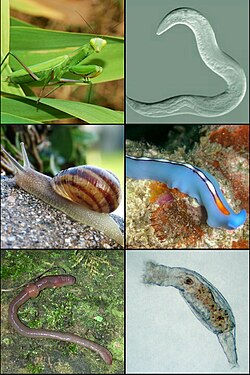Top Qs
Timeline
Chat
Perspective
Protostome
Clade of animals whose mouth develops before the anus From Wikipedia, the free encyclopedia
Remove ads
Protostomia (/ˌproʊtəˈstoʊmi.ə/) is the clade of animals once thought to be characterized by the formation of the organism's mouth before its anus during embryonic development. This nature has since been discovered to be extremely variable among Protostomia's members, although the reverse is typically true of its sister clade, Deuterostomia.[1][2] Well-known examples of protostomes are arthropods, molluscs, annelids, flatworms and nematodes. They are also called schizocoelomates since schizocoely typically occurs in them.
Together with the Deuterostomia and Xenacoelomorpha, these form the clade Bilateria, animals with bilateral symmetry, anteroposterior axis and three germ layers.[3]
Remove ads
Protostomy
Summarize
Perspective
In animals at least as complex as earthworms, the first phase in gut development involves the embryo forming a dent on one side (the blastopore) which deepens to become its digestive tube (the archenteron). In the sister-clade, the deuterostomes (lit. 'second-mouth'), the original dent becomes the anus while the gut eventually tunnels through to make another opening, which forms the mouth. The protostomes (from Greek πρωτο- prōto- 'first' + στόμα stóma 'mouth') were so named because it was once believed that in all cases the embryological dent formed the mouth while the anus was formed later, at the opening made by the other end of the gut.[4][1] It is now known that the fate of the blastopore among protostomes is extremely variable; while the evolutionary distinction between deuterostomes and protostomes remains valid, the descriptive accuracy of the name protostome is disputable.[1]
Protostome and deuterostome embryos differ in several other ways. Secondary body cavities (coeloms) generally form by schizocoely, where the coelom forms out of a solid mass of embryonic tissue splitting away from the rest, instead of by enterocoelic pouching, where the coelom would otherwise form out of in-folded gut walls.[5]
Remove ads
Evolution
Summarize
Perspective
The common ancestor of protostomes and deuterostomes was evidently a worm-like aquatic animal of the Ediacaran. The two clades diverged over 600 million years ago. Protostomes evolved into over a million species alive today, compared to ca. 73,000 deuterostome species.[6]
Protostomes are divided into the Ecdysozoa (e.g. arthropods, nematodes) and the Spiralia (e.g. molluscs, annelids, platyhelminths, and rotifers). A modern consensus phylogenetic tree for the protostomes is shown below.[7][8][9][10][11][excessive citations] The timing of clades radiating into newer clades is given in mya (millions of years ago); less certain placements are indicated with dashed lines.[12]
| Bilateria |
| |||||||||||||||||||||||||||||||||||||||
Remove ads
See also
- Embryological origins of the mouth and anus
- Urbilaterian, a hypothethical common ancestor to Protostomes and Deuterostomes
References
External links
Wikiwand - on
Seamless Wikipedia browsing. On steroids.
Remove ads




